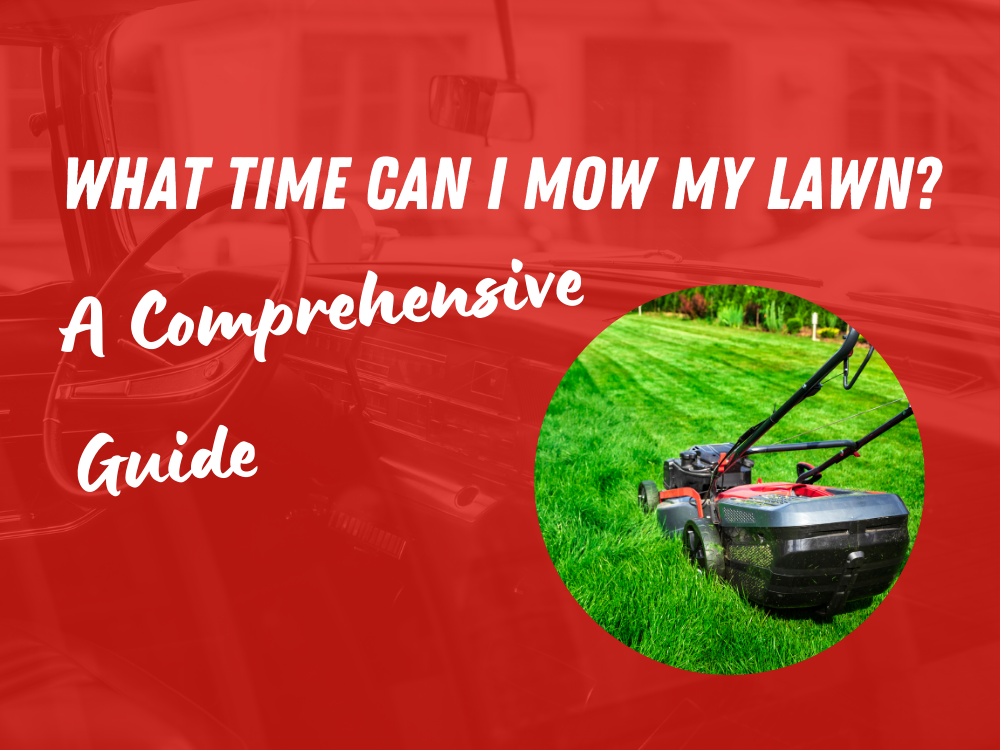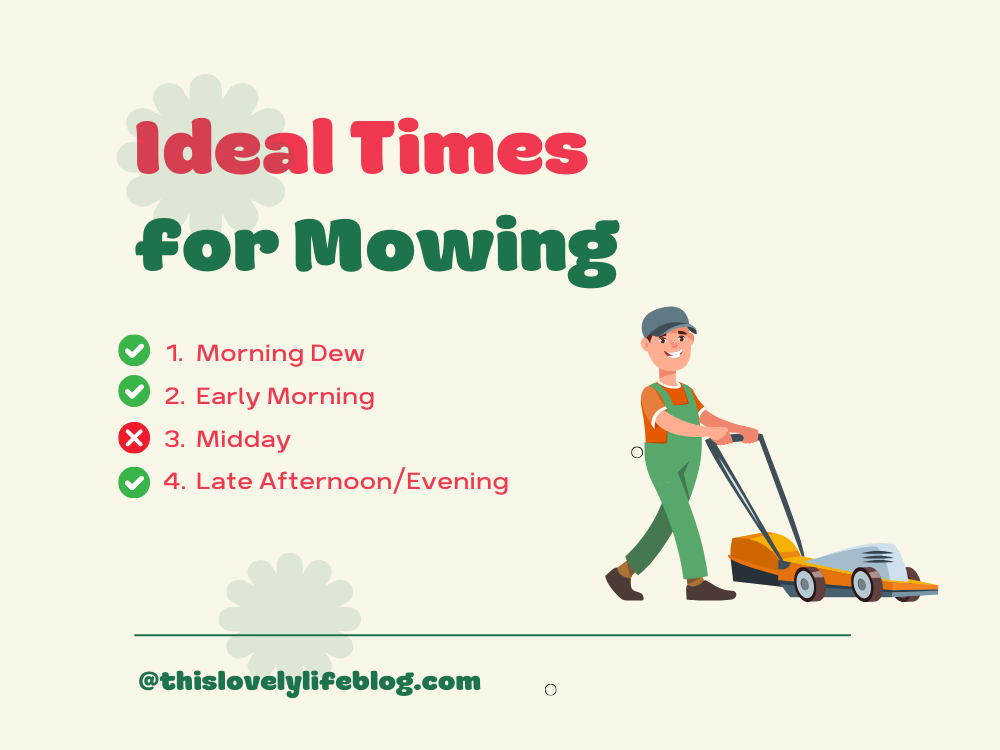
Many homeowners wonder what time they can start mowing their lawns without disturbing their neighbors or violating any noise ordinances. While there is no universal answer to this question, there are some general guidelines to follow that can help ensure a peaceful coexistence with neighbors and compliance with local laws.
In most residential areas, the acceptable time to start mowing the lawn is between 8 a.m. and 9 a.m. on weekdays and Saturdays. On Sundays, it is generally recommended to wait until 10 a.m. or later to start mowing. However, these times may vary depending on where you live, so it’s important to check your local noise ordinances to avoid any potential fines or conflicts with neighbors. Additionally, it’s always a good idea to be considerate of those who work late shifts or have young children who nap during the day.
Table of Contents
Understanding Lawn Mowing
Lawn mowing is an essential part of maintaining a healthy and attractive lawn. Regular mowing helps to keep grass blades at an optimal height, which promotes healthy growth and prevents the lawn from becoming overgrown and unsightly. However, it is important to understand the basic principles of lawn mowing to ensure that the job is done correctly and efficiently.
One of the most important factors to consider when mowing a lawn is the height of the grass. Different types of grass have different optimal heights, and mowing at the wrong height can damage the lawn and promote weed growth. As a general rule, it is best to mow no more than one-third of the grass blade at a time. This helps to maintain a healthy root system and prevents the grass from becoming stressed.
Another important consideration when mowing a lawn is the frequency of mowing. The frequency of mowing depends on several factors, including the type of grass, the climate, and the season. In general, it is best to mow the lawn when the grass is dry and not during the hottest part of the day. Mowing too frequently can stress the grass and make it more susceptible to disease and pests.
When using a lawn mower, it is important to use the correct technique to ensure a clean and even cut. This includes keeping the blades sharp, mowing in a different direction each time, and overlapping each pass slightly to ensure that no patches of grass are missed.
Overall, understanding the basics of lawn mowing is essential for maintaining a healthy and attractive lawn. By following these simple guidelines, homeowners can ensure that their lawn is always looking its best.
Ideal Times for Mowing

When it comes to mowing a lawn, timing is everything. Mowing at the right time can help to ensure that your lawn stays healthy and looks great. Here are some ideal times for mowing your lawn:
Morning Dew
Mowing when there is still morning dew on the grass can be beneficial. The grass is softer and easier to cut, and the moisture can help to keep the grass healthy.
Early Morning
Mowing early in the morning is a great time to mow your lawn. The grass is still moist from the dew, making it easier to cut. Additionally, the cooler temperatures in the morning can help to prevent stress on the grass.
Midday
Mowing during midday should be avoided if possible. The heat of the day can cause stress on the grass, and it can also be dangerous for the person mowing due to the high temperatures.
Late Afternoon/Evening
Mowing in the late afternoon or evening can be a good time to mow your lawn. The temperatures are cooler, and the grass has had time to dry out from the morning dew. However, mowing too late in the evening can be noisy and disturb your neighbors.
Lawn Care Tips
Maintaining a healthy lawn requires proper care and attention. Here are some tips to keep in mind when mowing your lawn:
- Mow when the grass is dry: Wet grass can clog the mower and make it difficult to cut the grass evenly. It is also important to avoid mowing the lawn when it is raining or when the grass is damp.
- Keep mower blades sharp: Dull blades can tear the grass, leaving it vulnerable to disease and pests. Sharpen the blades regularly to ensure a clean cut.
- Adjust the cutting height: The cutting height will depend on the type of grass and the season. For most grasses, a cutting height of 2-3 inches is recommended. For a new lawn, it is best to keep the cutting height higher until the grass is well established.
- Don’t cut too much at once: Removing more than one-third of the grass blade can stress the grass and leave it vulnerable to disease and pests. It is best to mow frequently and remove only a small amount of grass at each mowing.
- Leave grass clippings on the lawn: Grass clippings can provide valuable nutrients to the soil and help to retain moisture. However, if the grass is too long or wet, it may be necessary to bag the clippings to prevent clumping.
By following these lawn care tips, you can maintain a healthy and vibrant lawn throughout the year.
Understanding Grass Types
When it comes to mowing your lawn, it’s important to understand the type of grass you have. Different grass types have different mowing requirements, and failing to follow those requirements can lead to an unhealthy lawn.
Here are some common grass types and their mowing requirements:
Bermuda Grass
Bermuda grass is a warm-season grass that requires frequent mowing during its growing season. It should be mowed to a height of 1-2 inches every 5-7 days. Cutting it too short can damage the grass and leave it vulnerable to weeds and disease.
Bluegrass
Bluegrass is a cool-season grass that should be mowed to a height of 2-3 inches. It grows best in the spring and fall, and may require less frequent mowing during the summer months. Cutting it too short can stress the grass and make it more susceptible to pests and disease.
Fescue
Fescue is a cool-season grass that should be mowed to a height of 2-3 inches. It grows best in the spring and fall, and may require less frequent mowing during the summer months. Cutting it too short can damage the grass and make it more susceptible to weeds and disease.
Zoysia
Zoysia is a warm-season grass that should be mowed to a height of 1-2 inches every 7-10 days. Cutting it too short can damage the grass and leave it vulnerable to pests and disease.
In summary, understanding your grass type and its mowing requirements is crucial for maintaining a healthy lawn. By following these guidelines, you can ensure that your lawn stays lush and green throughout the year.
Regional and Seasonal Considerations
When it comes to mowing the lawn, there are regional and seasonal considerations to take into account. The type of grass, climate, and weather conditions can all impact when it is best to mow the lawn.
In regions with warm climates, such as the southern United States, grass tends to grow year-round. This means that homeowners may need to mow their lawns more frequently than those in cooler climates. In contrast, areas with colder climates may have a shorter growing season, which means that homeowners may only need to mow their lawns a few times a year.
During the summer months, it is generally best to mow the lawn in the early morning or late afternoon when temperatures are cooler. This can help prevent stress on the grass and reduce the risk of damage. In the fall and spring, it is important to keep an eye on the weather conditions. Wet or frosty grass can be easily damaged, so it is best to wait until the grass has dried before mowing.
It is also important to consider the growth cycle of the grass. Some grasses, such as Bermuda grass, grow more quickly in the summer months and may require more frequent mowing. Other grasses, such as fescue, grow more slowly and may only need to be mowed once a week.
Overall, it is important to consider the regional and seasonal factors that can impact when it is best to mow the lawn. By taking these factors into account, homeowners can ensure that their lawn stays healthy and looks its best year-round.
Potential Risks of Incorrect Mowing
Mowing the lawn is a common household chore that many homeowners undertake to keep their lawn looking neat and tidy. However, incorrect mowing can lead to several potential risks that can damage the lawn and even cause harm to the person mowing. Here are some of the risks associated with incorrect mowing:
Damage to the Lawn
Mowing the lawn too short can cause damage to the grass. This is because the grass needs its leaves to produce food through photosynthesis. Cutting the grass too short can remove too much of the leaf surface area, making it difficult for the grass to produce enough food to support growth. This can lead to a thin and patchy lawn.
Additionally, mowing the lawn when it is wet can cause damage to the grass. Wet grass is more prone to tearing, which can create an uneven and unsightly lawn. It can also cause soil compaction, which can lead to poor drainage and root growth.
Slipping and Falling
Mowing the lawn on a slope can be dangerous if the mower loses traction and starts to slide. This can cause the person mowing to lose control of the mower and potentially slip and fall. It is important to be aware of the slope of the lawn and avoid mowing on steep inclines.
Wear and Tear on the Mower
Mowing the lawn incorrectly can cause wear and tear on the mower. This can include damage to the blades, belts, and other moving parts. It is important to keep the mower blades sharp and to avoid hitting rocks or other hard objects that can damage the blades.
Fungal Growth
Mowing the lawn too short can create ideal conditions for fungal growth. This is because shorter grass allows more sunlight to reach the soil, which can create warm and moist conditions that are perfect for fungi to grow. This can lead to unsightly brown patches on the lawn and can even cause disease to spread to other plants in the area.
In conclusion, it is important to mow the lawn correctly to avoid potential risks and damage. Homeowners should be aware of the risks associated with incorrect mowing and take steps to avoid them. This includes mowing at the correct height, avoiding mowing on wet grass, being aware of the slope of the lawn, keeping the mower blades sharp, and avoiding hitting hard objects.